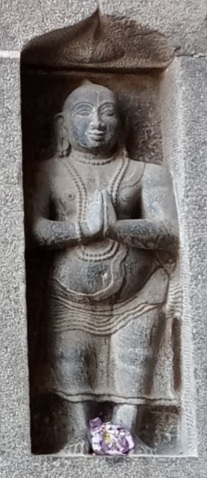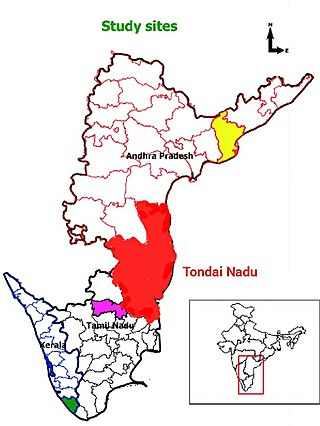
The Pandya dynasty, also referred to as the Pandyas of Madurai, was an ancient Tamil dynasty of South India, and among the four great kingdoms of Tamilakam, the other three being the Pallavas, the Cholas and the Cheras. Existing since at least the 4th to 3rd centuries BCE, the dynasty passed through two periods of imperial dominance, the 6th to 10th centuries CE, and under the 'Later Pandyas'. Under Jatavarman Sundara Pandyan I and Maravarman Kulasekara Pandyan I, the Pandyas ruled extensive territories including regions of present-day South India and northern Sri Lanka through vassal states subject to Madurai. Pandya dynasty is the longest ruling dynasty in the world.

The Kakatiya dynasty was a Telugu dynasty that ruled most of eastern Deccan region in present-day India between 12th and 14th centuries. Their territory comprised much of the present day Telangana and Andhra Pradesh, and parts of eastern Karnataka, northern Tamil Nadu, and southern Odisha. Their capital was Orugallu, now known as Warangal.

Jatavarman Sundara I, also known as Sadayavarman Sundara Pandyan, was an emperor of the Pandyan dynasty who ruled regions of Tamilakam, Northern Sri Lanka, and Southern Andhra between 1250–1268 CE. He is remembered for his patronage of the arts and Dravidian architecture, along with refurbishment and decoration of many Kovils (temple) in the Tamil continent. He oversaw a massive economic growth of the Pandyan empire. On the eve of his death in 1268 CE, the second Pandyan empire's power and territorial extent had risen to its zenith till Nellore and Kadapa by defeating Telugu Chola rulers Vijaya Gandagopala, Manumasiddhi III of Nellore Cholas and Ganapatideva of Kakatiyas.

Rudrama Devi, also known by her regnal name Rudra-deva Maharaja, was a Kakatiya queen who ruled substantial parts of present-day Telangana and Andhra Pradesh in southern India. She was among the few successful female rulers in Indian history.

The Telugu Chodas or Telugu Cholas were rulers who ruled parts of present-day Andhra Pradesh, Telangana and southern Odissa as samantas (vassals) of the Pallavas, and later as vassals of the Imperial Cholas. There are many branches like Renati Chodas, Pottapi Chodas, Konidena Chodas, Nannuru Chodas, Nellore Chodas and Kunduru Chodas. The origins of the Telugu Chodas are diverse; while some claimed descent from Karikala, others were local Telugu-speaking feudatories of the Cholas in the Andhra region who added "Choda" to their names as an honorific.

Rajaraja II was a Chola emperor who reigned from 1150 to 1173. He was made his heir apparent and Co-Regent in 1146 and so the inscriptions of Rajaraja II count his reign from 1146. Rajaraja's reign began to show signs of the coming end of the dynasty.

Kulothunga III was a Chola emperor who ruled from 1178 to 1218 CE, after succeeding his elder brother Rajadhiraja II. Kulothunga Chola III gained success in war against his traditional foes. He gained victories in war against the Hoysalas, Pandyas of Madurai, Cheras of Venad, the Sinhalese kings of Polonnaruwa, as well as the Telugu Cholas of Velanadu and Nellore. He also restored Chola control over Karur, which were ruled by the Adigaman chiefs as vassals of the Cholas. He drove out the Hoysalas under Veera Ballala II who had made inroads in the Gangavadi and adjoining areas of Tagadur in Kongu country in an effort expand their territory. However, during the last two years of his reign, he lost in war to the resurgent Pandyas, heralded a period of steady decline and ultimately, demise of the Cholas by 1280 CE. Kulottunga III had alliances with the Hoysalas. The Hoysala king Veera Ballala married a Chola queen called Cholamahadevi and gave his daughter Somaladevi in marriage to Kulottunga III.

Rajendra Chola III came to the Chola throne in 1246 CE. Rajendra began to take effective control over the administration, and epigraphs of Rajendra Chola III indicate there was civil war ending with the death of Rajaraja Chola III. Rajendra's inscriptions laud him as the "cunning hero, who killed Rajaraja after making him wear the double crown for three years".

Kopperunchinga II was a Kadava chieftain, who succeeded his father Kopperunchinga I and continued his successes against the Hoysalas. Since the Chola power no longer constituted a threat, Kopperunchinga II acted as the de facto protector of the Chola king and helped him maintain his position on the throne. As he expanded his territorial holdings, Kopperunchinga II assumed such titles as Maharajasimha, Khadgamalla, Kadava Pallava, Alappirandan, Avaniyalappirandan, Kanakasabhapathy, etc. He has left numerous inscriptions mainly in the present Cuddalore, Viluppuram, Mayiladuthurai and Chengalpattu districts and a few have also been found in the erstwhile North Arcot district and Chittoor district. A Thiruvannamalai inscription mentions that he drove the telungar to the north to perish. Ultimately, however, the resurgence of the power of the Pandya kingdom of Madurai ended Kopperunchinga's reign and the Kadava dynasty.

Veera Ballala II was the most notable king of the Hoysala Kingdom. His successes against the Yadavas of Devagiri, the Southern Kalachuris, the Pandyas of Madurai and the waning Western Chalukya Empire, and his domination over the diminishing Cholas of Tanjore took the Hoysalas to the peak of their power. The historian Chaurasia claims that by the end of the 12th century, Ballala II's conquests had made the Hoysalas the most powerful dynasty of Deccan. According to historian Derrett, Ballala II was "the most outstanding among Hoysala kings", and historian William Coelho in comparing Ballala II to King Vishnuvardhana writes, "he vied in glory with his grandfather".
Vira Narasimha II was the Hoysala king of Kuntala from 1220 until 1234, with his kingdom located in what is now Karnataka in India. During his reign the Hoysalas gained much influence in the affairs of the Tamil country. He defeated the Kadavas and Pandyas and levied a tribute. He acted as a support to Chola king Rajaraja Chola III, who was possibly his son-in-law, against Pandya incursions. During his rule, Vira Narasimha made Kannanur Kuppam near Srirangam his second capital, with an intent to maintain close watch and control over affairs in Tamil country. Later he fought for the Chola cause again and marched all the way to Rameswaram. The Kannada poet Sumanobana was the court poet of King Vira Narasimha II.

Cholas of Nellore also known as Nellore Chodas or Nellore Cholas, were one of the branch of Chola families who ruled over parts of Andhra Pradesh in the 11th and 14th centuries. They were chieftains to Imperial Cholas, Kakatiyas and Western Chalukyas and ruled over the Nellore region. The dominance of Nellore Cholas grew towards the end of the Velanandu Chola dynasty, they claimed descent from the early Chola Tamil king Karikala Chola.
Jayapa or Jaya was a military commander (senani) under the Kakatiya king Ganapati-deva, whose core territory included the Telugu-speaking region in present-day Andhra Pradesh and Telangana.
Pratāparudra, also known as Rudradeva II, was the last monarch of the Kakatiya dynasty of India. He ruled the eastern part of Deccan, with his capital at Warangal.

Ravivarman, styled Maharaja Ravivarman, Kulasekhara was the ruler of Venatu, with capital at port Kolambam (Quilon), southern India between 1299 – 1316/7. He – in all likelihood – was a descendant of the ancient Cheras. and was the son-in-law of the Pandya ruler of Maravarman Kulasekhara. Ravivarman raided large parts of southern India in a short period by skillfully taking advantage of the weakening of the Pandya kingdom and the confusion prevailed after the Khalji raids (1311).

Toṇḍaimaṇḍalam, also known as Toṇḍai Nāḍu, is a historical region located in the northernmost part of Tamil Nadu and southernmost part of Andhra Pradesh. The region comprises the districts which formed a part of the legendary kingdom of Athondai Chakravarti. The boundaries of Tondaimandalam are ambiguous – between the river basins of Penna River and Ponnaiyar River. During the reign of Rajaraja I, this region was called as Jayankonda Cholamandalam.
Krishna, also known as Kanha or Kannara, was a ruler of the Seuna (Yadava) dynasty of Deccan region in India. He successfully invaded the Paramara kingdom of Malwa, and fought inconclusive wars against the Vaghelas and the Hoysalas. The Yadava inscriptions also credit him or his generals with several other victories, but veracity of these claims is doubtful.
Prola II was a Kakatiya chief who ruled the area around Anumakomda as a vassal of the Kalyani Chalukyas. He was the father of Rudra-deva, the first sovereign ruler of the Kakatiya family.

Ganapati-deva was the longest reigning monarch of the Kakatiya dynasty of southern India. He brought most of the Telugu-speaking region in present-day Andhra Pradesh and Telangana under the Kakatiya influence by war or diplomacy.
Amba-deva was a 13th-century chief who carved out an independent principality in present-day Andhra Pradesh in southern India. He was a member of the Kayastha family, whose members were vassals to the Kakatiya monarchs. Amba-deva succeeded his elder brother Tripurari as the Kayastha chief in 1272, and soon gave up allegiance to the Kakatiya queen Rudrama. He defeated several Kakatiya subordinates, and also fought against the neighbouring Pandyas and their vassals to carve out an independent principality with its capital at Valluru-pattana. A Kakatiya force sent by Rudrama's successor Prataparudra defeated him in mid-1291.











